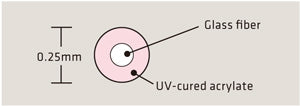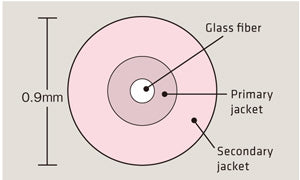Optical fibers are made of glass designed to guide light along its length by total internal reflection. Glass fibers have a nominal diameter of 125 microns (0.125 mm) and are protected with a plastic sheath covering, forming diameters of 250 μm or 900 μm. The central part of the glass fiber is to guide the light called the "core" and the "cladding" around it has a low refractive index ratio to the "core" to confine the light that is guided. Quartz glass is fragile; therefore, it is covered with a protective sheath. There are three typical coatings used to incorporate optical fibers.

Primary Coated Fiber
This is covered with UV-cured - acrylate nominally 0.25 mm in diameter. Because it has an exceptionally small diameter, it has excellent capacity for cabling of large numbers of fibers and is widely used.

Secondary fiber jackets are
either tight or semi-tight jacketed fibers. This is an optical fiber covered with thermoplastic to a diameter of 0.9mm. Compared to 0.25mm fiber, it is stronger, easier to handle and widely used in LAN wiring and other small fiber count cables.

Ribbon Fiber
Ribbon fiber provides an excellent way to increase the efficiency of connector assemblies and facilitate quality splices for increased productivity. Ribbons are made of 4, 8 or 12, for fiber counts as large as 1000 of colored fibers are easily removed by mass splicing with standard strippers or easily stripped for single fiber access UV acrylate material encapsulation. Ribbons can be spliced in a single fusion splicer with mass-fusion for easy identification of high fibercount cables.


